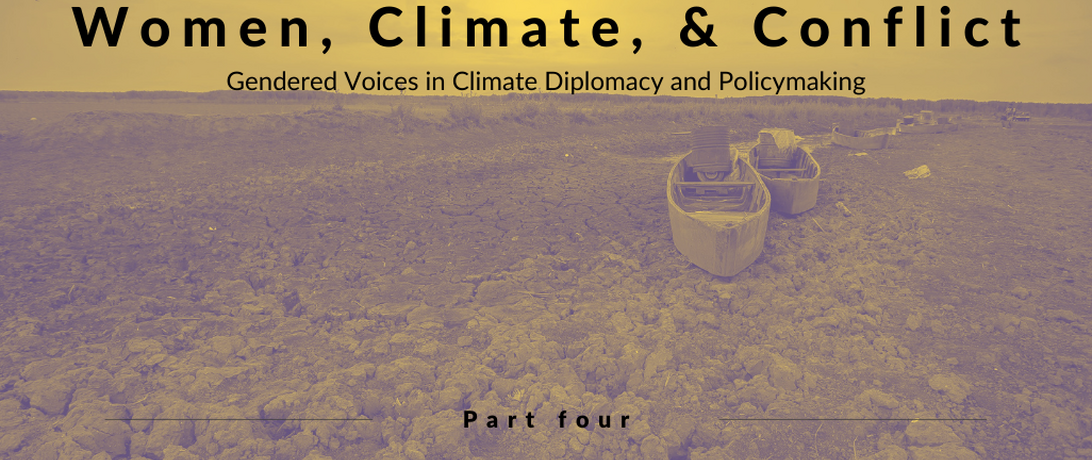
Part four of our guest blog series exploring the nexus of gender, conflict and climate change.
As a guest blog, the views expressed in this publication do not necessarily reflect the views of Our Secure Future or One Earth Future.
We must explore the nexus of gender, climate and security if we hope to build resilient, thriving communities in the future. In installations one and two of this series, we looked at the interplay between conflict and climate, noting that climate change is expected to intensify existing political instabilities and insecurities, with the potential to fuel conflict and violence. Climate change will pose direct threats to military readiness, materiel, budgets, and humanitarian response capabilities. In the presence of gender inequality, intersecting gender-climate-conflict risks create increased threats to women’s safety, health, and economic wellbeing. But seeing beyond common characterizations of women as either victimized or virtuous, in installation three, we looked at the many ways women demonstrate their agency by being part of climate solutions. These are all much-needed approaches to managing the complexities of the triple nexus.
We now need nuanced, contextualized policies that provide the gender-sensitive climate-conflict strategies, resources, legal structures, funding, and training that communities require to address present and future climate challenges. While climate policies sometimes include gender and increasingly include conflict, rarely do they integrate both. Likewise, while Women, Peace and Security (WPS) policies frequently address conflict, most ignore the threats of climate change as well.
Operating in silos, policymakers often fail to see the intersectional nature of these risks. Is this a problem created by the novelty of the challenge – is the triple nexus so new that policymakers lack sufficient exposure to the combined gender-climate-conflict threats? Or could this perhaps be a result of the familiar problem of missing women’s voices within policymaking spaces? Likely it’s a bit of both. While civil society organizations, think tanks, and academics can work to overcome the information gap, the only solution for the policy gap is to center women’s voices, a problem that is only overcome through the meaningful, equal, and full involvement of women in policy and peacemaking leadership roles.
Women and National Climate Policymaking
Many studies already show that as gender equality in national politics increases, policies are more likely to reflect gender-inclusive approaches. For instance, foreign policy scholarship has demonstrated that increasing women’s political leadership in national governments tends to reduce corruption, boost educational outcomes, and improve public health. Women politicians may also de-prioritize military spending in favor of budgeting for community welfare programs. Conversely, as Valerie Hudson has shown, for every additional step in a women’s subjugation (including in the political sphere), a country is twice as likely to be unstable and violent, and one-and-a-half times more likely to experience episodes of terrorism.
Importantly for our purposes, with greater gender equality in national parliaments comes more stringent climate policies, and lower national carbon dioxide emissions as well. What happens when women have greater involvement in policymaking where the issues of gender, climate change, and international security meet? Research I’m just completing now (to be published soon) suggests that increasing women’s participation in national parliaments has the effect you’d expect: it increases the likelihood that a country will develop policies that tackle the intersectional nature of the women-climate-conflict nexus.
Gender in Climate Diplomacy and Peacemaking
Another sphere in which it is important to center women’s voices in the triple nexus is climate diplomacy. The Wilson Center, in their recent Foreign Policy Is Climate Policy report, has pointed out that we can no longer ignore climate change because there is no security sphere that climate change doesn’t touch: from great power competition to the future of democracy, global financial systems to multilateralism, migration to geoengineering. If climate security risks are going to drive future instability and risk, women – who are both impacted by and active problem-solvers in climate matters – should be present at those climate peacemaking tables. The WPS Participation Pillar, after all, admonishes that it be so.
In 2017, UN Climate Change Executive Secretary Patricia Espinosa called participants to the UN Climate Change Conference in Bonn (COP23) to seize the opportunity of increasing women’s leadership in UN climate diplomacy processes. However, the global conversation has been very slow to recognize the role of gender in international climate security. Research from the International Rescue Committee suggests that in environmental peacebuilding – including climate peacemaking – women’s participation has generally been tokenistic.
More work must be done to tap into the perspectives and ingenuity of women and indigenous leaders in national and international policymaking and diplomacy. As I have demonstrated throughout this series, the inclusion of women in climate policymaking is not just the right thing to do, it’s the strategic thing to do. The quest to recognize and address the gender-climate-conflict nexus has just begun. Certainly at this pivotal stage, we can still set a more equitable and transformative agenda for what will prove to be one of the most significant security challenges of our time.
Article Details
Published
Written by
Topic
Program
Content Type
Opinion & Insights